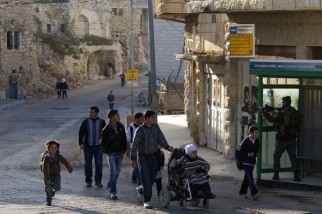December 24, 2012 12:02 by Yarden Frankl

It is easy to claim that a particular news organization is biased against Israel if you can point to a list of articles that are factually incorrect. Photos that have been manipulated or misleading headlines can be identified and used as evidence of bias. When a news outlet is confronted with the fact that it has published information that is wrong, it will usually issue a correction or retraction. Every now and then, an apology will accompany the admission of guilt.
But can a news site show a bias even if it publishes factually accurate stories?
Absolutely. If the reporting overwhelmingly focuses on one side of a conflict, then the resulting coverage will, by definition, be biased. This holds true even if all the stories are reported accurately.
The same holds true for photographs. A photograph can be of a real event, but if the picture lacks context, then it can do more to mislead than inform. But even with context, if a news site chooses to use images that show a conflict from the perspective of one side in a conflict more often than showing an alternative view, then it is steering readers towards a skewed understanding of the conflict.
The only way to spot these examples of bias is to take a snapshot of a newspaper’s reporting over the course of a few months. Only by combing through all press coverage of a specific subject can conclusions be drawn as to whether that newspaper is free of bias.
Range and Methodology
We took a time period of seven months in 2012, from April 1 until November 30, and reviewed all coverage in the LA Times related to Israel. Over that time period, we examined 110 articles featured on the LA Times website. We looked at several parameters for this study:
1. Articles where the main content is negative toward Israeli policy/actions compared to articles where the content is negative toward Palestinian policies/actions.
2. Images that reflect negatively on Israel or evoke sympathy for the Palestinians compared to images that reflect negatively on the Palestinians or evoke sympathy for Israelis.
3. Direct quotations critical of Israel/Israelis compared to those critical of Palestinians.
4. Headlines that reflect negatively on Israel compared to the Palestinians.
Findings:
1. Content: Articles are over six times more likely to be critical of Israeli actions.
We counted 38 articles in which the main content was critical of Israeli actions or reflected negatively on Israel. Articles about settlements, Palestinian prisoners, and Israeli military actions that resulted in the deaths of Palestinians dominated the coverage. Often these articles failed to give proper context to the story. In several examples, articles about Palestinian prisoners on hunger strikes fail to give Israel’s rationale for holding them in detention. Numerous articles detail the activities of Israeli settlers without providing the proper context behind settlements.
In contrast, there were no articles about the well-known corruption of the Palestinian Authority. No articles on the Palestinian education system — which has been documented glorifying terrorists as role models. No articles about Palestinian smuggling of weapons into Gaza. The only articles that mentioned Palestinian rocket attacks on Israeli civilians were included in articles describing the Israeli responses to such attacks.
Examples of articles that reflect negatively on Israel:
i) May 1, 2012: Palestinians in Israeli jails begin third week of hunger strike
This article neglects to include an Israeli explanation as to why these prisoners were detained. Two organizations that support the prisoners are used as sources while no one explains Israel’s side of the story. It is legitimate for the LA Times to report on the issue, but the number of articles on this subject, as well as the way they are written, will contribute to a negative perception of Israel. While the issue of Palestinian prisoners on a hunger strike is important, should it be one of the main issues through which Israel is perceived?
ii) July 26, 2012: Number of Jewish settlers in West Bank Passes 350,000 mark
This article fails to put the issue of settlements into context. It does not provide any history or legal opinions on the settlements, and the way it is written casts a negative light on the settlements. Again, settlements are one important issue that should be covered, but there are many others.
2. Images: Three to one expressing sympathy for the Palestinians / reflecting negatively on Israel.
An image showing a Palestinian funeral is not necessarily a fraudulent one. If it is documenting an actual event, then it is accurate. However, when the LA Times reader is overwhelmed with pictures of Palestinian casualties or Israeli soldiers pointing weapons at what appear to be Palestinian civilians, biased conclusions will inevitably be drawn.
By contrast, there were very few images of Israeli casualties or of Israelis forced to flee to bomb shelters. One would assume that were the reader to see three times as many images of Israelis as the victims of a terrorist war, they would come away with a different understanding of the conflict.
The above picture shows the body of a Palestinian killed while preparing to launch a rocket into Israel. This man has been implicated in previous rocket attacks into Israel. By publishing a large number of similar images, the LA Times is giving viewers a biased look at the conflict. Why not a picture of Israeli children hiding in a bomb shelter from one of the rockets he had launched?
The man above is a leader of the Hamas terrorist group. Does the picture reflect the most important context to give viewers an accurate understanding of who he is? Or does it make him seem like a sympathetic figure?
Without providing more information, it looks like this Israeli soldier is aiming his weapon at the Palestinian civilians walking by. In Hebron, many soldiers and civilians have been attacked by terrorists and must be on alert at all times. Pictures like the one above give the viewer a sense that Israeli soldiers are threatening innocent Palestinians.
3. Direct Quotations: Majority critical of Israeli actions / leaders.
Direct quotations can have a huge impact on the weight of a story. The LA Times tends to use quotations — from both Palestinians and Israelis — that are critical of Israeli actions. While there is an occasional story where a Palestinian is quoted criticizing the Palestinian Authority or Hamas, these are few and far between. Does this mean that there is no criticism? Or can the lack of quotes be because in general, Palestinians are wary of going on record to criticize the PA or Hamas for fear of repercussions?
Examples of direct quotations favoring Palestinian side / critical of Israel:
i) “They are killing us and then forcing us to pay for it, too,” Natche said. “The courts are racist and we knew what the decision would be from the start.” – Palestinians evicted from two East Jerusalem houses, April 18, 2012
ii) “A victory for righteousness, justice and humanitarian principles.”
Palestinian Authority Prime Minister Salam Fayyad on UNESCO’s vote to include holy sites in the biblical city of Bethlehem on the World Heritage list, despite Israel’s objections. – Palestinians hail World Heritage listing of Bethlehem holy sites, June 29, 2012
iii) “The documents show that Israel used its control to put pressure on the Hamas regime by making civilians suffer.” – Sari Bashi, director of the Israeli group Gisha, Israeli military calculated caloric needs of Gazans during embargo, October 17, 2012
iv) Peace Now accused the government of making “a mockery of the rule of law” by allowing “a radical minority” to create facts on the ground and undermine a possible future agreement with the Palestinians. – Two new settler outposts go up in West Bank, activists report, October 31, 2012
4. Headlines: Four times more likely to reflect negatively on Israel.
A headline is the first piece of information a reader will see about a news story and has a huge impact on the way the news story will be perceived. A more passive headline that talks about “rockets being launched” will create less of an impression than a more direct one along the lines of “Israeli Army shoots….”
In our survey, we found that headlines were four times more likely to reflect negatively on Israel as on the Palestinians. This is not surprising considering our finding about content being weighted against Israel. Yet just because an article describes a subject that is critical of Israel, it does not mean that the headline needs to be so weighted. Often a story that does cover both sides of an issue can bear a completely one-sided headline. Look at these examples. If all you saw was the headlines, what impressions would you have of the conflict?
Examples:
“Arab citizens in Israel bemoan lack of policing” – The article points out that initially the Arab residents were against an additional Israeli police presence. But the reader would not know this from the headline.
“Gaza militants killed in Israeli airstrike” – The headline does not mention that those killed were preparing to launch rockets at Israel.
“Jewish extremists accused of vandalizing Jerusalem monastery” – The headline does not convey that this relatively minor, though serious act of vandalism was condemned by Israeli officials.
“Palestinian family loses its Jerusalem home to Israeli settlers” – The headlines lacks any indication that this issue has been fought in the courts for years and that the courts decided that the family was not the legal owner of the property in question.
Summary
The examples of bias in the above articles, images and headlines are admittedly subtle. Taken individually, one could argue that they do not represent classic examples of anti-Israel bias. But that is what makes their impact worse. By painting a picture of the conflict in which Israel is depicted negatively and the Palestinians are ignored, the LA Times inevitably shapes public perception of Israel and the conflict.
Please share this report with the LA Times by filling out the feedback form here.
Source material can be found at this site.












